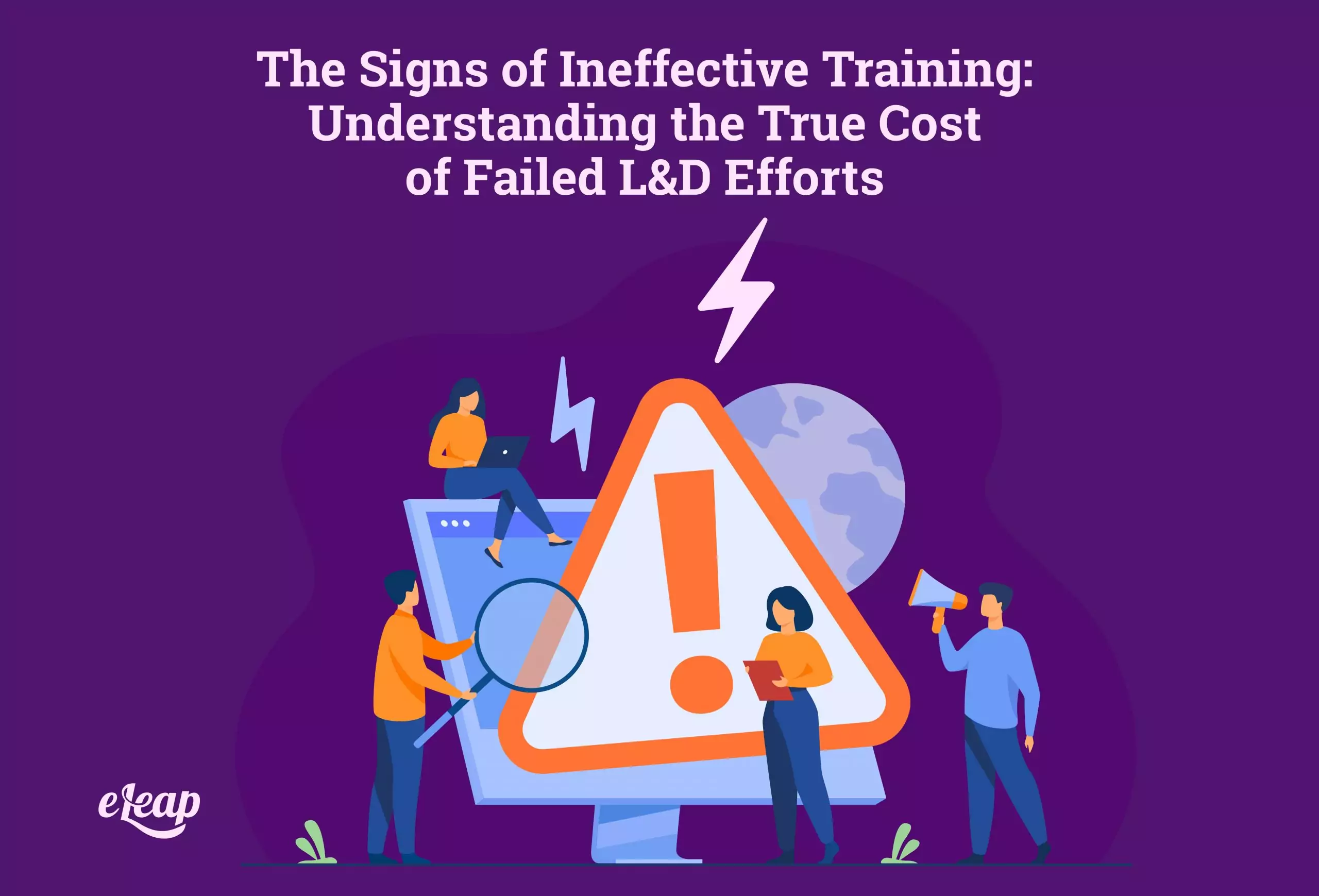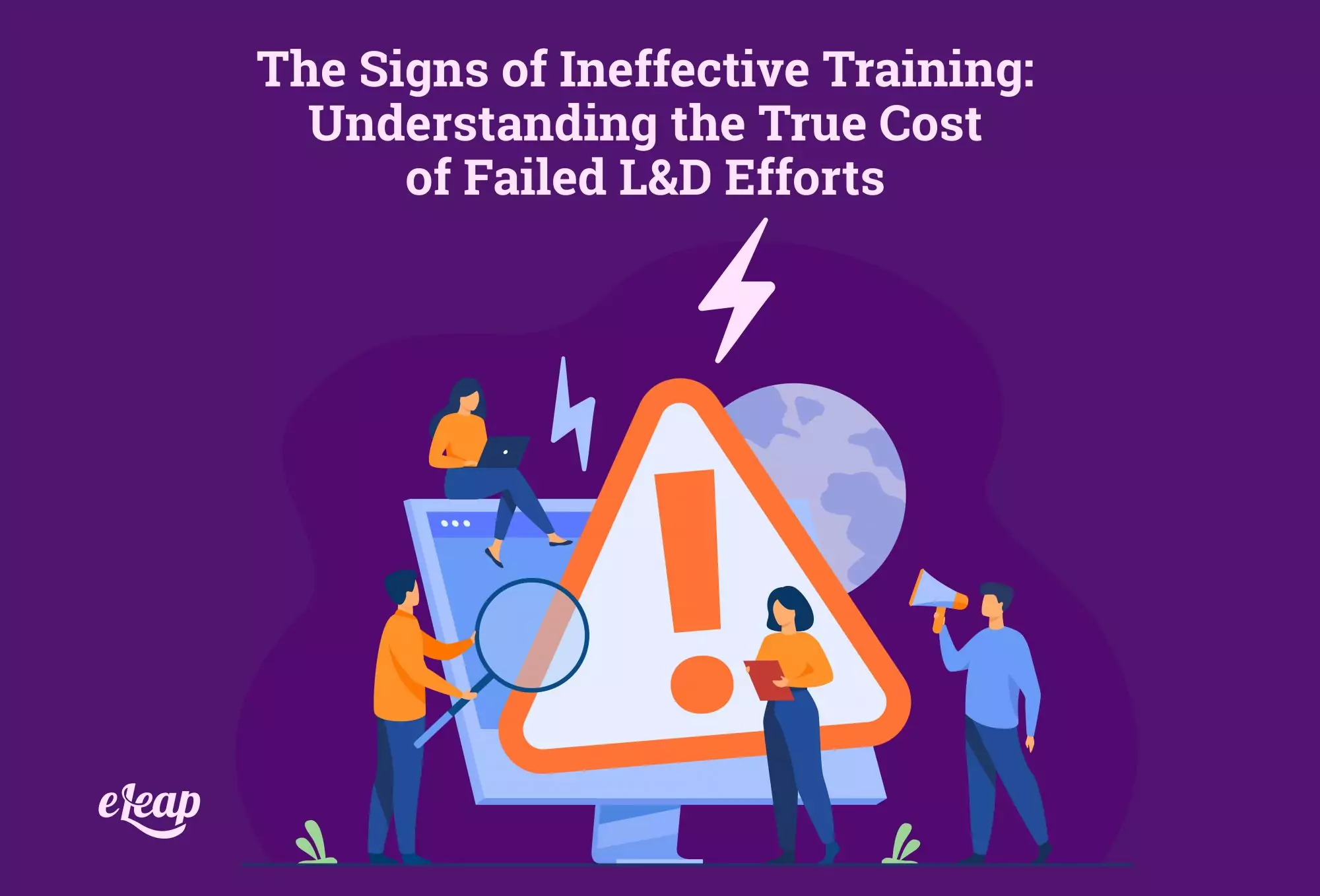The Signs of Ineffective Training

Ineffective training can cause serious problems for an organization. Employee training should deliver critical benefits. Your L&D initiatives should help you build a stronger, more resilient organization, avoid legal/compliance issues, and engage your employees. If your training efforts are not yielding those results, chances are good that they are ineffective. Get a 15-minute free consultation and learn how to increase the effectiveness of your training.
That said, it can be challenging to determine whether your training efforts are effective. That is particularly true for managers and leaders on the ground. From a 30,000-foot view, it becomes easier to pinpoint signs of ineffectiveness and take corrective action. This post will explore some of the most important signs that your training programs are ineffective and how those failures will ultimately cost your organization.

Low Engagement
Employee engagement has become something of a modern holy grail for employers, but it can be challenging to measure. It may be easier to measure its absence. According to a survey by McLean & Company, disengaged employees cost your company roughly $3,400 for every $10,000 in salary, ultimately costing the American economy $350 billion annually. Those are staggering numbers, and they’re because low engagement impacts just about every metric out there, from employee retention to customer satisfaction.
Low Productivity
Another sign that your training is ineffective is if your employee productivity levels are low or continue to dwindle. With adequate training, productivity increases. This is because employees learn new, more effective ways to work through practical training. Good training is also engaging and provides employees with wide-ranging experiences, both of which feed into their ability to produce at high levels.
Inefficiencies
Inefficiencies in systems create breakdowns, bottlenecks, and loss. Inefficiency in worker performance can mimic those symptoms. Once you eliminate problems with your in-house systems, any remaining related problems are likely due to poor training. Employees learn the skills necessary to improve efficiency with high-quality, accurate training. They also gain access to new tools that further increase efficiency.
However, the benefits of accurate employee training don’t stop with access to knowledge and tools – there’s a powerful psychological element here, too. A well-designed training program reduces employee frustration and simultaneously shows the organization’s commitment to its success, which improves buy-in and engagement, increases productivity and feeds into better efficiency.
Increased Employee Churn
Turnover is a constant for most businesses. However, if you’re experiencing increased or sustained high turnover, it’s a good sign that your training programs are ineffective. Today’s employees demand more from their employers, and if they cannot get what they need from your L&D program, they will seek it out elsewhere.
It is not just an inability to learn, grow, and develop, although those missing elements are certainly drivers of discontent. Employees who are not supported with high-quality training materials feel less engaged, more neglected, and increasingly dissatisfied with their employment. There’s an unspoken message that the lack of training (or the presence of low-quality training material) is because the employer simply does not care about helping employees learn and develop.
Decreased Customer Satisfaction
Whether you’re in a B2B or B2C sector, your employees are responsible for customer satisfaction. One key sign that your training is ineffective is decreased customer satisfaction. That will ultimately lead to customers looking to your competitors to fill their needs, which negatively impacts market share, profitability, brand recognition/value, and so much more.
Ineffective training leaves employees feeling dissatisfied and disengaged. That drives poor customer service – dissatisfied employees simply don’t deliver the best possible experience for your customers. Every negative experience reflects on your brand, as well. Today’s customers, both B2B and B2C, are increasingly intolerant of negative experiences at any touch point. With the increasingly competitive market, they will seek out another company almost immediately. You owe it to your organization and team to reduce the incidence of ineffective training.
Quality Plummets Overall
Quality is a critical success metric for virtually all business processes. You look at quality in production, customer service, employee performance, and more. If your training is effective, you can expect quality to be high across the board. However, if you have noticed that your quality seems to be stagnating rather than improving or that it’s declining overall, your training programs may be ineffective.
Disengaged, unsupported, dissatisfied employees will not deliver the quality that you need for success. That’s true in all aspects of the business, from customer service to marketing. As the quality of your services and/or products declines, it affects customer perceptions of your business. Can you afford for your brand to become synonymous with low-quality or negative experiences? No company can withstand that sort of perception shift, and the market is littered with failed businesses that were unable to turn things around.
Changing the Paradigm
The signs above can all indicate that your training is ineffective, not engaging, and fails to deliver value. However, you must delve into the situation to determine what is going wrong, where, and why. With that information in hand, it becomes possible to make accurate changes that drive positive results.
One tool that can help you drill down into the effectiveness of your training program(s) is the Kirkpatrick Model. This four-tiered pyramid enables you to hone in on critical breakdowns in your training and connect the dots. Thereby enacting meaningful change that supports your employees, building their knowledge and skills, and ensuring better productivity, engagement, efficiency, and quality across the board.
From the base “reaction” level to the peak “results” level, this model helps you gain critical insight, set goals, and measure progress. It can also be implemented relatively quickly.
Tracking Your Success
While the Kirkpatrick Model is a potent tool, it’s essential to have the right systems for measuring and tracking progress and results. Your learning management system (LMS) is the key to leveraging the model effectively. At eLeaP, our LMS offers advanced functionality, powerful tracking capabilities, granular reporting, and the flexibility and connectivity that only comes from cloud-based technology. Take a free trial of eLeaP and see how you turn your training program around. You can also contact us today to learn more about our LMS and how we can help boost the effectiveness of your training efforts.